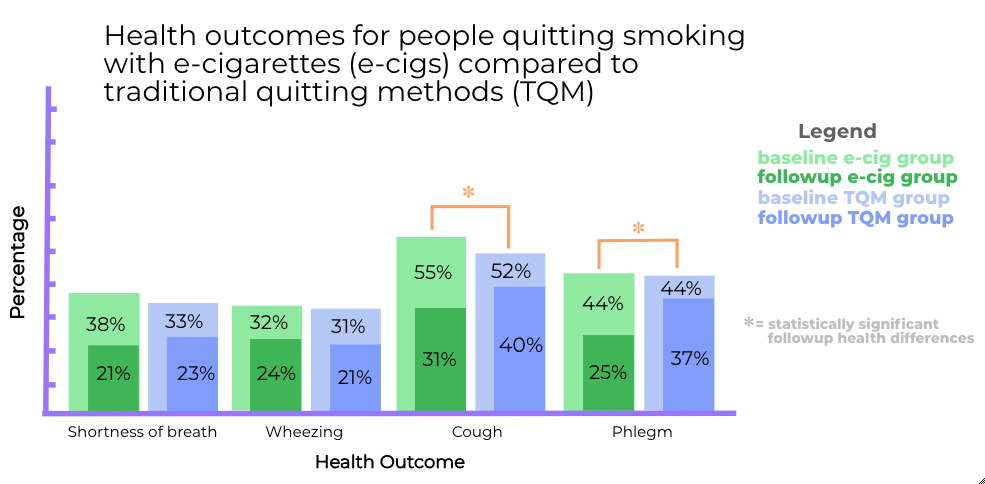A variety of options exist for quitting smoking, like using lozenges, gums, or patches. A first-person story by one of our op-ed writers demonstrates that people who smoke are also interested in whether e-cigarettes are an effective quitting tool. Current smokers are more likely than nonsmokers to think that e-cigarettes are a healthier option than smoking traditional cigarettes, but research on the health effects of e-cigarettes as a quitting tool is relatively new. This week, ASHES reviews a study by Peter Hajek and colleagues that explored smoking abstinence and health outcomes among people using traditional quitting options compared to those who switch to e-cigarettes.
What is the research question?
Are traditional quitting methods or e-cigarettes more effective for quitting smoking? How does each approach affect a person’s health?
What did the researchers do?
The researchers recruited 886 adult cigarette smokers1 from three health services located in the United Kingdom. Participants were randomized to quit smoking with the help of either traditional quitting methods (e.g., gums, patches) or e-cigarettes. Participants also met with a clinician weekly for at least four weeks after their initial quit date. Participants responded to questions about sustained abstinence2 from smoking and health outcomes (i.e., cough, phlegm, wheezing, and shortness of breath) in a baseline interview and in a follow-up interview one year later. The researchers used logistic regression analyses to assess differences between groups on sustained abstinence from smoking and health outcomes at the one-year follow up.
What did they find?
Eighteen percent of the e-cigarette group achieved sustained abstinence at follow up, compared to about 10% of those using traditional quitting methods. This difference amounted to the e-cigarette group experiencing 1.83 times greater likelihood of reporting abstinence at follow up compared to those using traditional quitting methods. Both groups reported better health outcomes between baseline and follow up, but those in the e-cigarette group reporting cough or phlegm at baseline were significantly more likely than those using traditional quitting methods to report no symptoms of either cough or phlegm at the follow up (see figure).

Figure. Health outcomes for people quitting smoking with e-cigarettes compared to traditional quitting methods (TQM). Click image to enlarge.
Why do these findings matter?
When people who want to stop smoking have the support of a clinician, e-cigarettes might be a more effective tool than traditional quitting methods. Smokers who are concerned about health problems like cough or phlegm might benefit from switching to e-cigarettes if they are able to maintain abstinence from smoking longer. Although those who used e-cigarettes were more likely to quit than those who used traditional methods, only about one in five of them did so.
Every study has limitations. What were the limitations in this study?
Self-reported smoking behaviors might be inaccurate because people could be unwilling to tell the truth or have trouble remembering their behavior. It is unclear how e-cigarettes affect health outcomes beyond one-year following treatment.
For more information:
SmokeFree offers tools and tips for quitting and maintaining abstinence from smoking tobacco. For additional tools, please visit the BASIS Addiction Resources page.
— Pat Williams
What do you think? Please use the comment link below to provide feedback on this article.
________________
1 Participants were eligible for study inclusion if they were not pregnant or breast-feeding, had no preference in favor of nicotine replacement or e-cigarettes, and were not currently using either.
2 The researchers defined sustained abstinence as reporting smoking no more than five cigarettes beginning two weeks after quitting until the one-year follow up.





Fiona Williston April 9, 2019
I’m curious as to how abstinence was defined. Did it mean that the e-cigarette group were no longer smoking or using e-cigs or were they only regular cigarette free?
Pat April 9, 2019
Hi Fiona,
Footnote 2 above addresses part of your question. To be considered abstinent at follow up, members of either group had to report smoking less than five tobacco cigarettes between the second week of quitting and one-year followup. Participants could still use e-cigarettes if they were assigned to that group as long as they met the requirements of this definition of abstinence from tobacco cigarettes.
All the best,
Pat